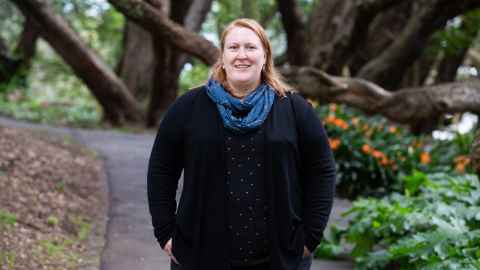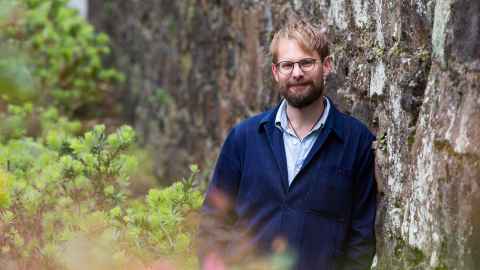Giving biodiversity the best chance
25 November 2020
Creating a safe place for our wildlife to thrive is not only key to preserving biodiversity but also a crucial ingredient for a sustainable world and our own existence.
THE FREQUENT SIGHTING of native birds during lockdown-enforced neighbourhood walks
has served to highlight the value of wildlife in urban environments, but it also raises critical
questions about the importance of biodiversity and sustainability.
“We’re just starting to realise how we rely on nature to provide us with economic benefits, but also with health and well-being” says Associate Professor Margaret Stanley from the School of Biological Sciences.
Research indicates that being surrounded by nature can lower blood pressure and reduce the incidence of depression, but Western societies tend to separate people from nature which makes increasing biodiversity that much more difficult to achieve if there’s a lot of intensification.

Wildlife-friendly urban spaces
Surveying vegetation around Auckland primary schools is an integral part of a current study to determine whether people have equal access to nature. And already, Margaret says there’s clear evidence that low socio-economic areas have very low urban forest. “They’ve missed out on the street trees in particular.”
Much of Margaret’s research is about “sneaking biodiversity into cities”, but one of the challenges for schools is that the Ministry of Education doesn’t fund trees and vegetation because they’re not considered to be assets or infrastructure. Creating multifunctional spaces near sports fields is one option. “You can have quite diverse vegetation around the outside that supports biodiversity” says Margaret, “rather than just single oak trees every twenty metres around the edge of the park.”
Margaret and her students have also investigated the negative impact that excess light and noise are having on wildlife and birdsong in urban environments. A recent project mapped light pollution across Auckland and found that, by international standards, virtually nowhere was untouched – not even the Waitākere Ranges or the Hauraki Gulf. “We need to encourage people to shield their lights so the spill is going downward and not creating massive light pollution all night.”
Another project has measured noise in relation to native bird species, and revealed there were more native bird species where the decibel levels of traffic was lower. For Margaret, it’s one more reason to flip our car fleet to electric vehicles as soon as possible.
Predator Free by 2050
A key element in the push for greater biodiversity and sustainability is the need to develop social capital through community engagement which is currently being demonstrated through predator control.
Funded by a Rutherford Discovery Fellowship and the BioHeritage National Science Challenge, Associate Professor James Russell from the School of Biological Sciences and Department of Statistics was at the forefront of establishing the Predator Free 2050 project in 2016. Having a nationwide army of volunteers now supporting the cause is a source of great satisfaction. “The really big breakthroughs come in getting a whole country to mobilise towards it and accept it as a value proposition.”
Looking ahead, James is now collaborating with Manaaki Whenua Landcare Research on a major project to develop tools that will help eliminate the last remaining predators. Understanding ‘personality archetypes’ is a key part of the puzzle. “When the end comes, do you survive because you were the wiliest and smartest individual – or did you just get lucky?”
Understanding the last one to get caught – and the first one to come back – is also critical, so James is consulting with the Zero Invasive Predators (ZIP) group to develop detection tools that will identify the presence of pests – and prevent any reinvasion. “The way you catch the last one that’s evaded everything to date is very different to how you intercept the first one that’s coming back.”
Interestingly, he says the response to predators can be likened to the response to COVID-19. “New Zealand responded so well to COVID because we have learned so many lessons from all our other biosecurity actions across Predator Free New Zealand.”
Like COVID, invasive species are attributable to increasing globalisation and James says the key issue is how you respond. “No border is secure, that’s just the nature of reality. The question is, when it crosses through your border are you prepared to respond – and it’s exactly what we do for rats.”
But it’s not just about the battle to eliminate predators. “Predator Free New Zealand is not a panacea to the threats that these species face,” says James, which is why he’s undertaking new research into the impact of climate change and pathogens on the recovery of wildlife once the pests are gone.

Community involvement
The PF 2050 campaign is also a research focus for Dr Brendon Blue from the School of Environment. His aim, to explore how the restoration of ecosystems is being negotiated. “Predator Free 2050 doesn’t just need community consent, it also requires the community to be out there doing the work which I think is really quite fascinating.”
Funded by the George Mason Centre for the Natural Environment, Brendon is interviewing stakeholders about the social and political challenges of implementing such a large-scale community-oriented project. “It’s not like getting permission from people to lock the country down for a couple of weeks, this is something that happens over the next thirty odd years and potentially longer.
“Genuinely listening to people is perhaps one of the toughest parts” says Brendon, “especially if you have already decided what you want to achieve.” The difficulty of these conversations has been illustrated by community pushback over the use of 1080 poison in the conservation estate. As Brendon points out, “not everyone protesting 1080 is ‘crazy’ or a conspiracy theorist” but there are dangers in labelling people as such.“If you alienate people early on it’s just not going to work.”
There are signs that this challenge is being taken seriously, with more nuanced conversations taking place at a community level in some places. “There seems to be an increasing recognition that it’s necessary, and I think the approach is very different to what it might have been if we’d done this twenty years ago.”
Predator Free New Zealand is not a panacea to the threats that these species face.
As treaty partners and kaitiaki, Māori have a major stake in PF 2050 but have had mixed experiences. One of the more complex questions is around the ‘ownership’ of eradication projects. “Who decides what’s going to happen, and who does the work on the ground? Whose time gets paid, and who is expected to provide free labour?” are all legitimate questions, says Brendon.
The ethics of killing is another consideration. While the Government’s announcement of PF 2050 side-stepped that conversation, Brendon believes that it’s a debate worth having – especially with the next generation. “It seems to me that it’s a discussion that you need to be having with your kids, because society kills things and kids should probably know that.”
Brendon hopes the research will shed light on a range of environmental and social issues – from culling tahr and tackling kauri dieback to responding to COVID-19. “Just telling people what to do rather than engaging in a two-way conversation is never going to be a good solution to those kinds of issues longer term.”
And for James, PF 2050 isn’t about trying to wind New Zealand back to how it was a thousand years ago. That’s in the past he says. “What I want is New Zealand to be a place that’s not under threat in a thousand years’ time."
To support research restoring our unique natural environment visit: www.giving.auckland.ac.nz/environment

inSCight
This article appears in the December 2020 edition of inSCight, the print magazine for Faculty of Science alumni. View more articles from inSCight.
Contact inSCight.